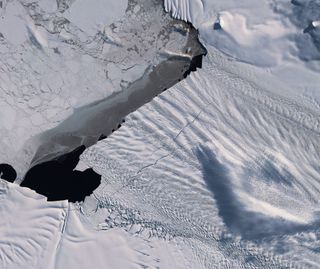One of Antarctica's fastest-shrinking glaciers just lost an iceberg twice the size of Washington, D.C.
Scientists worry that Pine Island and the neighboring Thwaites 'Doomsday' Glacier could be headed toward collapse.

Pine Island Glacier, one of the fastest-shrinking glaciers in Antarctica, has just lost another huge chunk of ice to the sea, continuing a troubling trend that has become a near-annual occurrence in the last decade.
Scientists at Copernicus, the European Union’s Earth observation program, have been closely monitoring the glacier since large cracks appeared near its edge in October 2019. Yesterday, those cracks finally cut a chunk of the glacier away (a process known as calving), releasing a giant jigsaw puzzle of fresh icebergs into the nearby Amundsen Sea. In total, the icebergs measure about twice the size of Washington, D.C., in area (more than 130 square miles, or 350 square kilometers), according to The Washington Post.
On its own, the recent calving event is not entirely surprising or particularly threatening to global sea levels; calving is a normal part of life for ice formations with sections that float on the water, according to NASA's Earth Observatory. Because ice at the edge of the glacier was already floating, this ice will not directly contribute to sea level rise when it inevitably melts.
Related: Today’s climate change is worse than anything Earth has experienced in the past 2,000 years
However, over the past two decades, calving events have been occurring much more frequently at Pine Island Glacier and the neighboring Thwaites Glacier (also known as the "Doomsday Glacier") as the surrounding ocean warms due to global warming. While large calving events used to occur at Pine Island Glacier every four to six years, they've now become a near-annual occurrence, according to NASA. In the last decade, huge chunks of the glacier calved away in 2011, 2013, 2015, 2017, 2018 and now in 2020.
As a result, the Pine Island and Thwaites ice shelves are retreating inland faster than new ice can form. Scientists worry that this persistent retreat could be a sign that a runaway melting cycle is in effect: As comparatively warm sea water laps at the newly exposed edges of an ice shelf, melting accelerates, the ice shelf stretches and thins, and further calving becomes ever more likely.
📢🔴The Pine Island glacier in #Antarctica 🇦🇶 has finally calved, creating many large icebergs! Check out these #Sentinel1 🛰️🇪🇺 captures from yesterday 09 Feb., last week 05 Feb. and 01 Oct., 4 months ago, when large cracks became apparent. pic.twitter.com/iubE8JffVRFebruary 10, 2020
According to NASA, the region around the two glaciers contains enough vulnerable ice to raise the ocean by 4 feet (1.2 meters).
Get the Space.com Newsletter
Breaking space news, the latest updates on rocket launches, skywatching events and more!
Pine Island's newest icebergs calved just days after scientists reported the hottest temperature ever recorded in Antarctica. On Thursday (Feb. 6), temperatures near a research base on the continent's northern edge reached 64.9 degrees Fahrenheit (18.3 degrees Celsius), the World Meteorological Organization reported. The previous record was 63.5 F (17.5 C), set in March 2015.
- Images of melt: Earth's vanishing ice
- The reality of climate change: 10 myths busted
- Top 10 ways to destroy Earth
Originally published on Live Science.
OFFER: Save at least 56% with our latest magazine deal!
All About Space magazine takes you on an awe-inspiring journey through our solar system and beyond, from the amazing technology and spacecraft that enables humanity to venture into orbit, to the complexities of space science.
Join our Space Forums to keep talking space on the latest missions, night sky and more! And if you have a news tip, correction or comment, let us know at: community@space.com.

Brandon has been a senior writer at Live Science since 2017, and was formerly a staff writer and editor at Reader's Digest magazine. His writing has appeared in The Washington Post, CBS.com, the Richard Dawkins Foundation website and other outlets. He holds a bachelor's degree in creative writing from the University of Arizona, with minors in journalism and media arts. He enjoys writing most about space, geoscience and the mysteries of the universe.


